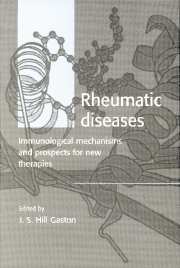Book contents
- Frontmatter
- Contents
- List of contributors
- 1 Implications of advances in immunology for understanding the pathogenesis and treatment of rheumatic disease
- 2 The role of T cells in autoimmune disease
- 3 The role of MHC antigens in autoimmunity
- 4 B cells: formation and structure of autoantibodies
- 5 The role of CD40 in immune responses
- 6 Manipulation of the T cell immune system via CD28 and CTLA-4
- 7 Lymphocyte antigen receptor signal transduction
- 8 The role of adhesion mechanisms in inflammation
- 9 The regulation of apoptosis in the rheumatic disorders
- 10 The role of monokines in arthritis
- 11 T lymphocyte subsets in relation to autoimmune disease
- 12 Complement receptors
- Index
8 - The role of adhesion mechanisms in inflammation
Published online by Cambridge University Press: 06 September 2009
- Frontmatter
- Contents
- List of contributors
- 1 Implications of advances in immunology for understanding the pathogenesis and treatment of rheumatic disease
- 2 The role of T cells in autoimmune disease
- 3 The role of MHC antigens in autoimmunity
- 4 B cells: formation and structure of autoantibodies
- 5 The role of CD40 in immune responses
- 6 Manipulation of the T cell immune system via CD28 and CTLA-4
- 7 Lymphocyte antigen receptor signal transduction
- 8 The role of adhesion mechanisms in inflammation
- 9 The regulation of apoptosis in the rheumatic disorders
- 10 The role of monokines in arthritis
- 11 T lymphocyte subsets in relation to autoimmune disease
- 12 Complement receptors
- Index
Summary
Introduction
Adhesion mechanisms play extraordinarily diverse roles in many biological phenomena. These range from physiological events in early life, when they are crucial for the development of the embryo, to pathological processes, including tumour growth and metastasis. In some cases, adhesion molecules act as receptors for infective agents such as viruses and parasites. From the immunological point of view, they are involved in virtually every process involving cell contact from thymic selection to antigen processing, from antigen priming to cell activation, from cytotoxicity to lymphocyte recirculation. The last process is part of a sophisticated system that allows efficient surveillance of the various tissues in the body for the presence of infectious pathogens and ‘dangerous’ exogenous or endogenous antigens. However, when the immune response goes astray, these same mechanisms are often responsible for the perpetuation of inflammation. A classical example is provided by RA and the other chronic inflammatory arthropathies, where the persistent synovial inflammation is maintained, among other factors, by the continuous migration of inflammatory cells from the bloodstream into the joint. Adhesion mechanisms further contribute to the perpetuation of the inflammatory response by the retention of these cells within the tissues, through interactions with extracellular matrix components, and by facilitating contact-dependent immunological events.
In this review, I will concentrate firstly on the general mechanisms that regulate the process of leukocyte extravasation from the blood into the tissues. Secondly, I will discuss the additional mechanisms that finely tune this process to allow the selective migration of distinct leukocyte populations in specific conditions and into different organs. Thirdly, I will consider some of the mechanisms involved in cell migration, spatial orientation and retention within the tissues.
- Type
- Chapter
- Information
- Rheumatic DiseasesImmunological Mechanisms and Prospects for New Therapies, pp. 153 - 182Publisher: Cambridge University PressPrint publication year: 1999



